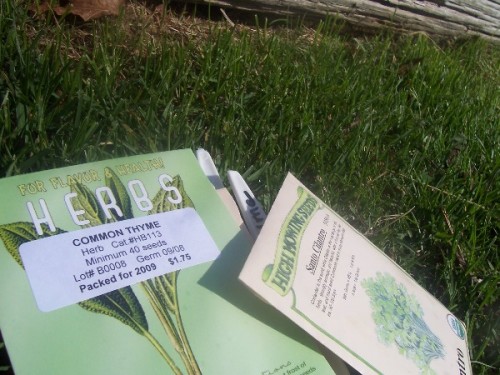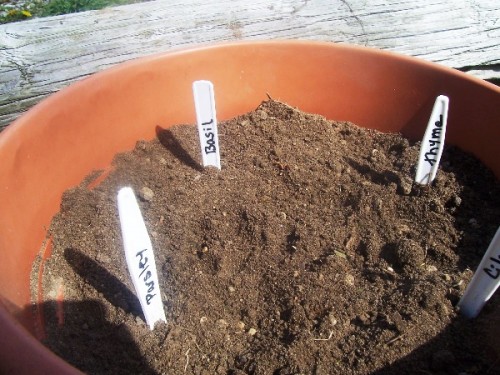Homesteading, Part 2: If You Eat It, You Should Grow It

As part of our journey towards homesteading as well as knowing where our food comes from, it is only logical that it should start in our own backyard.
One of the most fundamental principles of homesteading is growing your own food. If you consume it, you should work towards growing it or raising it yourself.
Last year marked our first year in gardening. It was exciting and we learned a lot, but we didn’t really grow all that much food. I was pregnant (and therefore tired & hot) and we were learning very slowly as we went.
But this year… this year we are hopeful… and busy in the garden. If the Lord wills, we wish to grow enough to feed us through the summer as well as store up as much as possible for the winter.
We have started to plant the cooler weather crops such as onions, garlic, peas and spinach. Seeing the little seedlings start to pop up is so exciting and we see something new every day.
We are going to wait a couple of weeks to plant warmer weather vegetables such as tomatoes and peppers, so we are now tearing up that section of the backyard in order to plant in the coming weeks.
To kick off this gardening season, I thought I would share with y’all what we are growing. Our planning was simple – whatever we eat or consume we should try to grow ourselves.
 Vegetables
Vegetables
- sugar snap peas
- shell peas
- spinach
- lettuce
- kale
- swiss chard
- cabbage
- green beans
- tomatoes – heirlooms, beefsteak and cherry
- bell peppers
- carrots
- cucumbers
- zucchini
- butternut squash
- spaghetti squash
- cayenne peppers
- jalapeno peppers
- garlic
- onions
Culinary Herbs
- chives
- oregano
- dill
- flat leaf parsley
- thyme
- basil
- cilantro
- sage
- lovage
Medicinal Herbs
- echinacea
- comfrey
- shepherd’s purse
- chamomile
- maca (no idea if this will work, and it’s actually a root)
- yarrow
- plantain
There may be more as we go forward, but for now this should keep us busy.
What are you growing this year?
This is a contribution to Fight Back Friday as well as Frugal Fridays.

 Vegetables
Vegetables
my list is very similar to yours. It just needs to stop raining so I can get it planted. My goal one day is to have a garden year round.
do you do all by seed? where do you get your seeds?
This is very impressive! I hope it works out well.
Will you continue to buy fruit this year? Do you plan to do fruit in future years?
I have a bunch growing my garden organically: yellow bell peppers, cilantro, lemons, strawberries, blueberries, blackberries, oranges, green onions, onions, garlic, thyme, artichoke, and lettuce!
Last year I tried out the square foot gardening (it was my first “real garden”) and I enjoyed it and produced some things (lettuce, tomatoes, cucumbers) but not enough to put up any of it or freeze. This year I’m renting a garden space (the space isn’t quite ready yet, I think it will be by next week) but I plan to grow lettuce, tomatoes, yellow squash, cucumbers, and some basil.
We live in a townhouse and have a VERY small yard so I have to do my gardening in pots on my deck. That limits me so right now we only have lettuce, tomatoes and basil. I plan to add some more stuff but don’t have my list finalized yet. I’m thinking zucchini, rosemary and peppers. I’m not sure how well all of these will do in pots either. I guess we’ll find out this year.
oooh, I’m hoping to get started on my veggie garden this weekend or early next week.
YAY for you. This all looks great! It’s already in the mid-90s here, so we’re ready for all our hot veggies. I think I’ve seen the last of the spinach until fall.
Thanks for sharing this in today’s Fight Back Fridays carnival. I can’t think of a better way to fight back against the dominate food supply than GROWING YOUR OWN!!
Cheers,
KristenM
(AKA FoodRenegade)
So far I’ve got strawberries, pole beans, several varieties of heirloom tomatoes, several varieties of lettuce, Swiss chard, spinach, broccoli, cauliflower, cucumbers, various squashes, beets, bok choy, carrots, dill, basil, thyme, lovage, chives, rosemary, sage, oregano, and tansy. Also French and Provencal lavenders and some comfrey. And a producing mulberry tree and some newly-planted raspberry bushes.
We’d love to grow ALL our produce, but I learned the hard way to work on it gradually. Each year we add a few more raised beds and fruit bushes. We’re not sure this is our “forever” house so we hate to do too much in the way of trees and bushes.
My partner and I just bought our first home and I’m working hard on the garden with the idea of becoming self sufficient (as much as possible given that we both work full time!). As it’s moving into winter here I’m growing cabbages, broccoli, broad beans, silver beet, leeks, parsnips and salad greens. I’m also trying to design my permanent garden layout so I can launch into it come spring. (A blueberry hedge will feature prominently!)
I just added my link to my blog. The last two entries are about buying and using a local, natural turkey.
I’m loving your blog this week, it is motivating me just right. 🙂 Regarding the maca, when I was researching it a few years ago, I saw a tidbit somewhere the mentioned the elevation that it was grown at and I believe that there were multiple varieties each selected for the elevation that it was grown in. I don’t know much about the Peruvian mountains, but I do remember it saying that the majority of the priced maca was grown quite high. Perhaps if you were to look into the sources that sell the maca starts/seed, then they would know the elevation they got it from??
Also, as for fruits. I have learned that the more native varieties (specifically those closer to their native wild counterparts) often have better success with larger harvests and more complex makeup (think nutrients and characteristics in apples described in Botany of Desire and the amazing squashes Indians grew – http://www.nativeseeds.org/) …This would include Blackberries and grapes such as concord for much of the country. (trees of antiquity is a good source of plant names/info although I’ve never ordered from them so don’t know more about them)
I’ll leave the research to you, but to be short so that you have key words in case you are interested:
Concords are slip skin (a characteristic that they are American grapes vs European grapes and are so have been less developed away from their native roots (pun:). Muscadane (sp?) grapes grow wild in the SE )
And Blackberries/Boysenberries can be thorn-less or not, erect or trailing. (my vote is on thornless and erect.)
You can propagate both plants easily so you can have more plants without ordering more. Blackberries are done by tip and Grapes are done by stems that have a bud(s) before it has decided if the bud is to be roots or leaves. Grapes do NOT like to be moved/transplanted, they like their roots to be left alone.